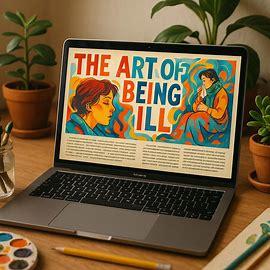Resilience in Rest – How Illness Shapes Our Inner Strength

When life is running smoothly, we rarely pause to think about the fragility of health. We move through routines, chase goals, and carry responsibilities as though tomorrow is guaranteed. Then illness arrives — sometimes briefly, other times with lingering persistence — and suddenly the ground shifts beneath us.
Illness is not simply a medical condition; it’s a profound life event that challenges our identity, values, and resilience. It slows us down, forces us to face vulnerability, and reshapes our perspective on what truly matters.
In this post, we’ll explore how the art of being ill can actually foster resilience, inner strength, and wisdom.
1. Redefining Strength Through Weakness
Most people equate strength with toughness — pushing through pain, working long hours, or never asking for help. Illness disrupts this illusion. It shows us that strength is not about ignoring weakness but about acknowledging it honestly.
When fever confines us to bed or fatigue keeps us from daily tasks, we’re faced with limitations. Rather than seeing this as defeat, the art of being ill reframes it: strength lies in patience, self-compassion, and trusting the healing process.
True resilience is not about pretending to be invincible. It’s about bending without breaking, softening instead of resisting, and allowing vulnerability to coexist with courage.
2. The Quiet Power of Rest
We live in a culture that glorifies productivity. Phrases like “hustle harder” or “sleep when you’re dead” fuel the idea that rest is laziness. Yet illness makes it impossible to ignore the body’s demand for restoration.
During these moments, we discover the quiet power of rest. Muscles knit themselves back together, immune systems recalibrate, and the mind regains clarity. What feels like inactivity is actually profound, invisible work.
This shift is central to the art of being ill — recognizing rest not as wasted time but as essential labor that rebuilds our resilience.
3. Illness as a Mirror of Priorities
When you’re lying in bed unable to carry out your usual tasks, priorities become starkly clear. The emails, chores, or minor annoyances fade into the background, while essentials — love, comfort, health, peace — rise to the surface.
Illness strips away the illusion of endless time. It reminds us that life is finite and that energy should be directed toward what truly matters. This realization can inspire lasting changes, from better self-care to nurturing relationships.
Through this lens, the art of being ill is also the art of reordering life around what nourishes us most deeply.
4. Emotional Resilience in Times of Weakness
Physical symptoms are only part of illness; emotional turbulence often accompanies them. Fear, frustration, or loneliness can weigh heavily. Yet within this turbulence lies an opportunity for emotional growth.
Learning to sit with discomfort, practicing self-kindness when energy is low, and leaning on supportive relationships all build emotional resilience. These skills don’t just help during sickness — they strengthen us for life’s wider challenges.
The art of being ill teaches us that resilience is not about suppressing emotions but about allowing them, processing them, and still moving forward.
5. Vulnerability as a Source of Connection
Few experiences expose vulnerability as quickly as illness. We may need help with meals, childcare, or even simple daily tasks. While uncomfortable, this reliance on others can deepen human connection.
Friends and family who step in with kindness remind us that interdependence is part of being human. Vulnerability fosters empathy, both for ourselves and for others facing hardship.
Embracing this lesson is part of the art of being ill — discovering that strength does not mean self-sufficiency but the ability to accept support with grace.
6. Creativity Born From Confinement
Being bedridden or limited in activity may feel frustrating, but it can also create space for creativity. History is filled with examples: authors who wrote masterpieces while recovering, artists who painted through illness, thinkers who reimagined life during convalescence.
When stripped of external busyness, the mind often finds new channels of expression. Even small acts — journaling a dream, sketching a thought, or composing music quietly — become healing rituals.
This is another dimension of the art of being ill: confinement as a canvas for creativity.
7. The Role of Mindfulness in Healing
Mindfulness practices, such as meditation or simple awareness of breath, can ease the discomfort of illness. By focusing attention on the present moment, we reduce the spiral of anxiety about the future or regrets about the past.
Instead of resisting pain or fatigue, mindfulness invites us to observe sensations with curiosity. This doesn’t eliminate discomfort, but it changes our relationship to it. We become less overwhelmed and more resilient.
Cultivating mindfulness during illness strengthens resilience beyond the sickbed. It becomes a life skill that enriches every experience.
8. The Spiritual Lessons of Illness
Illness often prompts deep reflection on life’s fragility. For many, this reflection takes a spiritual turn. Questions like “What gives my life meaning?” or “What do I want to leave behind?” emerge naturally.
Spiritual traditions across the world view illness as a teacher. It strips away distractions and brings us face-to-face with mortality. While unsettling, this confrontation can inspire gratitude, humility, and a greater sense of connection to something larger than ourselves.
The art of being ill acknowledges this spiritual dimension — seeing illness as a doorway to deeper wisdom, not just a detour from normal life.
9. Building Long-Term Resilience
Resilience cultivated during illness does not disappear when health returns. If we carry its lessons forward, it becomes part of our daily lives.
-
We listen to the body before exhaustion takes hold.
-
We honor rest as essential.
-
We cherish relationships more deeply.
-
We practice mindfulness even in busy seasons.
-
We redefine strength as patience and self-compassion.
This integration transforms temporary sickness into a lasting foundation of resilience.
10. Living With Gratitude
Finally, illness teaches us the value of gratitude. After recovering from even a minor flu, many people marvel at the simple joy of breathing easily, walking freely, or enjoying a meal.
Gratitude doesn’t deny the reality of illness; it grows from the recognition of contrast. Having tasted limitation, we appreciate freedom. Having endured discomfort, we treasure wellness.
The art of being ill culminates in this gratitude — not for suffering itself, but for the clarity it brings about life’s preciousness.
Conclusion
Illness challenges us physically, emotionally, and spiritually, but it also shapes resilience in profound ways. Through rest, vulnerability, mindfulness, and gratitude, we discover new dimensions of strength.
The art of being ill is ultimately about transformation — turning weakness into wisdom, fragility into empathy, and stillness into resilience.





